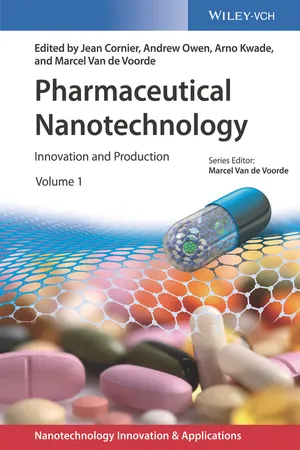1
History: Potential, Challenges, and Future Development in Nanopharmaceutical Research and Industry
Albertina Ariën1 and Paul Stoffels2
1Pharmaceutical Development and Manufacturing Sciences, Drug Product Development, Janssen Pharmaceutical Research & Development, Turnhoutseweg 30, Beerse, Belgium
2Chief Scientific Officer, Johnson & Johnson
Since the advent in 1906 of Dr. P. Erlich's magic bullets that would lookfor specific disease-causing agents in the human body, many therapies have been developed to increase the delivery of drugs to the target site. Nanoparticle-based delivery systems provide new opportunities to overcome the limitations associated with traditional drug therapy and aim to achieve both therapeutic and diagnostic functions in the same platform. These nanocarriers allow targeting of the medication to the site of action and release the drug in a controllable manner. Other features linked to nanopharmaceuticals are increased drug loading, increased bioavailability, enhanced efficacy, and increased safety. The nanocarriers are designed to be biocompatible and biodegradable.
A wide range of therapies are nowadays on the market or in late-stage development for the treatment of serious conditions such as cancer and infectious diseases [1,2]. Therapies include carriers of nanopharmaceuticals such as liposomes, lipid-based formulations such as solid lipid nanoparticles, nanocrystals, polymer-based nanoformulations, protein–drug conjugate nanoparticles, surfactant-based nanoformulations, metal-based nanoparticles such as iron oxide or gold nanoparticles, dendrimers, virosomes, and modified viruses.
The first product on the market employing nanotechnology was Doxil® that received US-FDA approval in 1995 for the treatment of AIDS-related Kaposi's sarcoma [3]. Doxil® are stealth liposomes encapsulating about 10 000 doxorubicin molecules [3,4]. Encapsulation minimizes side effects, such as cardiotoxicity, neutropenia, vomiting, myelosuppression, and alopecia, which are associated with high doses of free doxorubicin [5]. The incorporation of lipid and specifically cholesterol increases the bilayer cohesiveness and reduces leakage. The liposomes are designed by their size of approximately 100 nm and their pegylated surface to target to solid tumors via EPR effect (enhanced permeability and retention effect) and reduce toxicity to healthy tissues.
1.1 Nanopharmaceuticals in Cancer Therapy
Since, nanopharmaceuticals have become valuable arsenals in cancer therapy with enhancement of drug efficacy and decreased side effects. The efficiency of drug or gene delivery to a tumor site is dependent on the physicochemical properties of the delivery platform and a range of physiologically imposed design constraints, including clearance by the mononuclear phagocyte system and extravasation from circulation at the tumor site by the EPR effect.
The nanofeature of the pharmaceuticals contributes to enhanced solubility and chemical stability of the compounds along with potential protection from degradation by encapsulation into nanocarriers or coupling to synthetic polymers. Nanoparticle biodistribution and uptake by the reticuloendothelial system warranted the design of nanoparticles to evade rapid uptake such as lipid liposomes, albumin carriers, and PEGylation. PEGylation and conjugation to albumin respectively resulted in prolonged circulation and enhanced biodistribution of compounds, while the small size of nanopharmaceuticals led to improved tumor tissue accumulation [6].
Nanopharmaceuticals have improved biodistribution and targeting features as well as the potential of stimuli-sensitive microenvironments payload release. These collective features have led to the development of nanoparticle therapeutics of large antibody–drug conjugates (brentuximab vedotin and trastuzumab emtansine [6]) and small-molecule platforms such as liposomes (Doxil, DaunoXome, DepoCyt, Marqibo, Mepact, Myocet, Lipoplatin), polymeric nanoparticles (Eligard, Genexol, Opaxio, Zinostatin stimalamer), albumin nanoparticles (Abraxane), and metal-based nanoformulations (NanoTherm) [1,7].
Brentuximab vedotin and trastuzumab emtansine are antibody–drug conjugates (ADCs) with an anticancer drug conjugated to a targeting molecule. Brentuximab targets the protein CD30, a glycosylated phosphoprotein expressed by B cells, including B-cell lymphomas, some leukemias, and melanoma cancer stem cells [8–10]. Trastuzumab targets the human epidermal growth factor receptor 2 (HER2) overexpressed in HER2-positive breast cancer [11,12]. Monomethyl auristan E (MMAE) (brentuximab vedotin) and mertansine (trastuzumab emtansine) are too toxic to be used alone and hence coupling to a targeting antibody reduces toxic side effects. Several drug molecules are conjugated to each antibody via a valine–citrulline cleavable linker (brentuximab vedotin) or covalent linkage (trastuzumab emtansine) that is enzymatically degraded in endosomes following uptake. The relatively small number of approved ADCs highlights the difficulty in the development of nanotherapeutics to the clinic.
Since the introduction of Doxil on the market, many other liposomal formulations are developed [13]. More advanced liposomal carriers are designed to release their drug triggered by internal stimulus such as changes of pH or oxygen level or external stimulation such as local heating. Thermosensitive liposomes, such as ThermoDox, can release their payload in the tumor region with local heating owing to the gel-to-liquid crystalline phase change of the lipids at about 42 °C, a temperature that can be reached by local hyperthermia [13].
Another nanotherapeutic using temperature to induce tumor cell destruction or sensitization is NanoTherm, 15-nm-sized superparamagnetic iron oxide nanoparticles (SPION) coated with aminosilane. These nanoparticles are introduced directly in solid brain tumors and are exposed to a magnetic field that changes its polarity up to 100 000 times per second generating a local increase in temperature. Depending on the duration of exposure to the alternating magnetic field, the tumor cells may be destroyed or sensitized for further chemotherapy. Through the aminosilane coating, the nanoparticles remain localized, which allows repeated treatments [14].
Nanoparticle albumin-bound (nab™) technology is a nanotechnology-based drug delivery platform that exploits the natural properties of albumin to achieve a safe, solvent-free, efficient, and targeted drug delivery. Abraxane, or nab-paclitaxel, is a cremophor-free, albumin-bound 130-nm particle form of paclitaxel. The paclitaxel and albumin are not covalently linked but rather associated through hydrophobic interactions [15]. The particles of paclitaxel are in a noncrystalline, amorphous, readily bioavailable state, allowing for rapid drug release from the particles following intravenous administration. The albumin is thought to facilitate endothelial transcytosis and to play a r...
